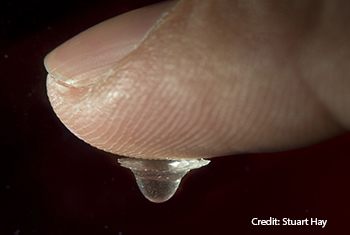
A single droplet lens suspended on a fingertip.
Today, manufacturers can make high performance, inexpensive lenses, but they still need to invest in expensive fabrication technologies. A team from Australia National University has found a way to use gravity, not costly machines, to make affordable lenses from transparent silicone (Biomed. Opt. Express, DOI:10.1364/BOE.5.001626). The new method could make microscopy more available to rural and developing areas, as well as classrooms; dermatologic applications could be hitting the market later this year.
To make the lenses, researchers bake a droplet of polydimethylsiloxane (PDMS), a silicone polymer, upside-down on a glass slide at 70 degrees Celsius. Gravity pulls the polymer down as it cures, creating a parabolic shape. Additional drops of PDMS can be added and baked on top of the first cured droplet to shorten the focal length. The lenses can magnify objects 160x with a resolution of 4 µm and cost less than one penny a piece. There are other low-cost lenses on the market, but the PDMS lenses are unique because they are shaped by gravity, not mold stamping equipment.
The lenses could have a wide variety of uses in many different fields—including dermatology. Recently, the team designed a printable attachment to mount their PDMS lenses onto a smartphone camera, turning it into a mobile dermascope—a device used to diagnose skin diseases. The attachment includes a battery compartment, lens window and two angled “pedestals” for LEDs. At a total cost of $2, the new dermascope, with a magnifying power of 60x, is incredibly less expensive than the $500 traditional models. The authors state that the lens-attachment combo should be commercially available in a few months.
.
